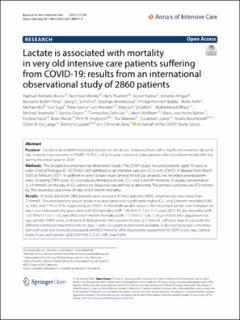Lactate is associated with mortality in very old intensive care patients suffering from COVID-19: results from an international observational study of 2860 patients
| dc.contributor.author | Bruno, Raphael Romano | |
| dc.contributor.author | Wernley, Bernhard | |
| dc.contributor.author | Flaatten, Hans | |
| dc.contributor.author | Fjølner, Jesper | |
| dc.contributor.author | Artigas, Antonio | |
| dc.contributor.author | Pinto, Bernardo Bollen | |
| dc.contributor.author | Schefold, Joerg C. | |
| dc.contributor.author | Binnebössel, Stephan | |
| dc.contributor.author | Baldia, Philipp Heinrich | |
| dc.contributor.author | Kelm, Malte | |
| dc.contributor.author | Beil, Michael | |
| dc.contributor.author | Sigal, Sivri | |
| dc.contributor.author | van Heerden, Peter Vernon | |
| dc.contributor.author | Szczeklik, Wojciech | |
| dc.contributor.author | Elhadi, Muhammed | |
| dc.contributor.author | Joannidis, Michael | |
| dc.contributor.author | Oeyen, Sandra | |
| dc.contributor.author | Zafeiridis, Tilemachos | |
| dc.contributor.author | Wollborn, Jakob | |
| dc.contributor.author | Banzo, Maria José Arche | |
| dc.contributor.author | Fuest, Kristina | |
| dc.contributor.author | Marsh, Brian | |
| dc.contributor.author | Andersen, Finn H. | |
| dc.contributor.author | Moreno, Rui | |
| dc.contributor.author | Leaver, Susannah | |
| dc.contributor.author | Boumendil, Ariane | |
| dc.contributor.author | De Lange, Dylan W. | |
| dc.contributor.author | Guidet, Bertrand | |
| dc.contributor.author | Jung, Christian | |
| dc.date.accessioned | 2021-11-25T15:05:05Z | |
| dc.date.available | 2021-11-25T15:05:05Z | |
| dc.date.created | 2021-09-18T09:40:36Z | |
| dc.date.issued | 2021 | |
| dc.identifier.issn | 2110-5820 | |
| dc.identifier.uri | https://hdl.handle.net/11250/2831537 | |
| dc.description.abstract | Purpose: Lactate is an established prognosticator in critical care. However, there still is insufficient evidence about its role in predicting outcome in COVID-19. This is of particular concern in older patients who have been mostly affected during the initial surge in 2020. Methods: This prospective international observation study (The COVIP study) recruited patients aged 70 years or older (ClinicalTrials.gov ID: NCT04321265) admitted to an intensive care unit (ICU) with COVID-19 disease from March 2020 to February 2021. In addition to serial lactate values (arterial blood gas analysis), we recorded several parameters, including SOFA score, ICU procedures, limitation of care, ICU- and 3-month mortality. A lactate concentration ≥ 2.0 mmol/L on the day of ICU admission (baseline) was defined as abnormal. The primary outcome was ICU-mortality. The secondary outcomes 30-day and 3-month mortality. Results: In total, data from 2860 patients were analyzed. In most patients (68%), serum lactate was lower than 2 mmol/L. Elevated baseline serum lactate was associated with significantly higher ICU- and 3-month mortality (53% vs. 43%, and 71% vs. 57%, respectively, p < 0.001). In the multivariable analysis, the maximum lactate concentration on day 1 was independently associated with ICU mortality (aOR 1.06 95% CI 1.02–1.11; p = 0.007), 30-day mortality (aOR 1.07 95% CI 1.02–1.13; p = 0.005) and 3-month mortality (aOR 1.15 95% CI 1.08–1.24; p < 0.001) after adjustment for age, gender, SOFA score, and frailty. In 826 patients with baseline lactate ≥ 2 mmol/L sufficient data to calculate the difference between maximal levels on days 1 and 2 (∆ serum lactate) were available. A decreasing lactate concentration over time was inversely associated with ICU mortality after multivariate adjustment for SOFA score, age, Clinical Frailty Scale, and gender (aOR 0.60 95% CI 0.42–0.85; p = 0.004). Conclusion: In critically ill old intensive care patients suffering from COVID-19, lactate and its kinetics are valuable tools for outcome prediction. | en_US |
| dc.language.iso | eng | en_US |
| dc.publisher | BMC | en_US |
| dc.rights | Navngivelse 4.0 Internasjonal | * |
| dc.rights.uri | http://creativecommons.org/licenses/by/4.0/deed.no | * |
| dc.title | Lactate is associated with mortality in very old intensive care patients suffering from COVID-19: results from an international observational study of 2860 patients | en_US |
| dc.type | Journal article | en_US |
| dc.type | Peer reviewed | en_US |
| dc.description.version | publishedVersion | en_US |
| dc.rights.holder | Copyright 2021 the authors | en_US |
| dc.source.articlenumber | 128 | en_US |
| cristin.ispublished | true | |
| cristin.fulltext | original | |
| cristin.qualitycode | 1 | |
| dc.identifier.doi | 10.1186/s13613-021-00911-8 | |
| dc.identifier.cristin | 1935571 | |
| dc.source.journal | Annals of Intensive Care | en_US |
| dc.identifier.citation | Annals of Intensive Care. 2021, 11, 128. | en_US |
| dc.source.volume | 11 | en_US |
Tilhørende fil(er)
Denne innførselen finnes i følgende samling(er)
-
Department of Clinical Medicine [2043]
-
Registrations from Cristin [9489]

